Originally posted on December 14, 2023 @ 7:24 am
When it comes to cooking, fresh ginger and ground ginger are two essential ingredients that add a zesty and aromatic flavor to dishes. But what if you find yourself without one or the other? Don’t worry, because we have you covered!
In this article, we will explore the world of fresh ginger substitute and ground ginger swap tips. Whether you need a substitute for fresh ginger or an alternative to ground ginger, we’ll guide you through the options and help you make the perfect swap for your recipes.
Table of Contents
Key Takeaways:
- Fresh ginger and ground ginger can be substituted for each other in recipes.
- Understanding the taste and characteristics of both fresh ginger and ground ginger is key to finding the right substitute.
- Ground ginger may have a slightly milder flavor compared to fresh ginger.
- Fresh ginger is commonly used in stir-fries and curries, while ground ginger is often used in baking and spice blends.
- Substitutes for fresh ginger include ground ginger, ginger paste, minced ginger, and frozen ginger.
- If you run out of ground ginger, you can use fresh ginger or other spices like allspice, cinnamon, nutmeg, or turmeric as substitutes.
- Crystallized ginger, also known as candied ginger, can be used as a substitute and adds sweetness and spice to dishes.
- If you don’t have ginger or any of its substitutes, spices like allspice, cinnamon, nutmeg, turmeric, and cardamom can provide similar flavors.
- Ginger offers various health benefits, including anti-inflammatory properties, aiding digestion, and reducing nausea.
- You can find fresh ginger, ground ginger, and crystallized ginger in most grocery stores or online.
- Try out different recipes that incorporate ginger to explore new flavor combinations.
What Does Ginger Taste Like?
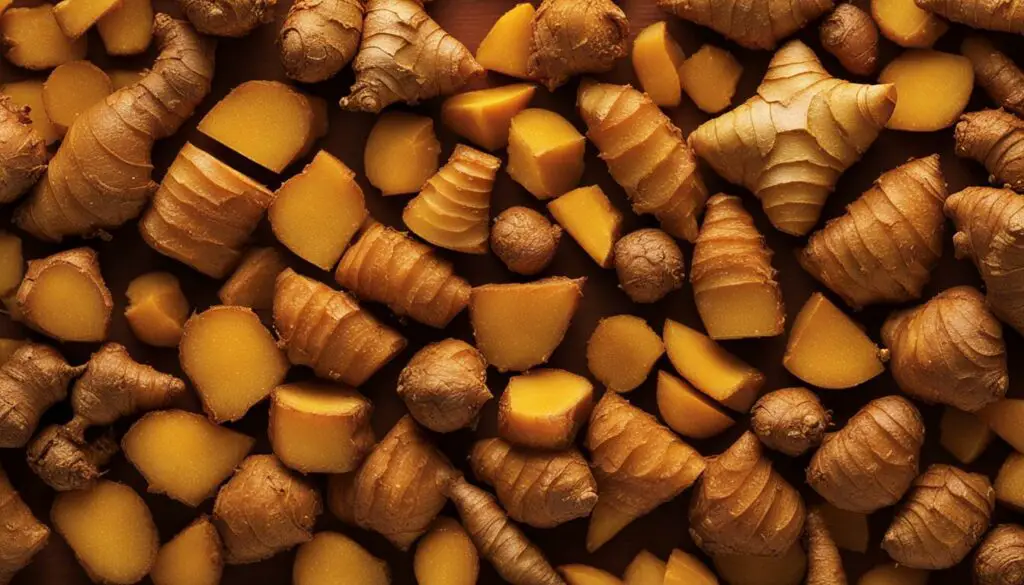
Ginger is a versatile and flavorful spice that adds a unique taste to dishes. It has a distinctive combination of peppery, sweet, and pungent flavors that make it stand out in the culinary world. The taste of ginger can be described as zingy and earthy, with a subtle heat that lingers on the palate.
Whether you use fresh ginger, ground ginger, or crystallized ginger, they all share similar qualities in taste. However, there are some slight differences between them. Fresh ginger has a vibrant and intense flavor, with a strong aromatic profile. It provides a bright and sharp kick to recipes.
On the other hand, ground ginger is made from dried and powdered ginger, which gives it a more concentrated flavor. While it retains the zingy and pungent characteristics of fresh ginger, its taste may be slightly more muted. Ground ginger is commonly used in baking, spice blends, and other dishes where a stronger ginger flavor is desired.
Understanding the taste of ginger is crucial when substituting it in recipes. Whether you’re swapping between fresh and ground ginger or exploring other substitutes, having a grasp of ginger’s flavor profile will help you create delicious dishes that capture the essence of this versatile spice.
Fresh Ginger vs. Ground Ginger
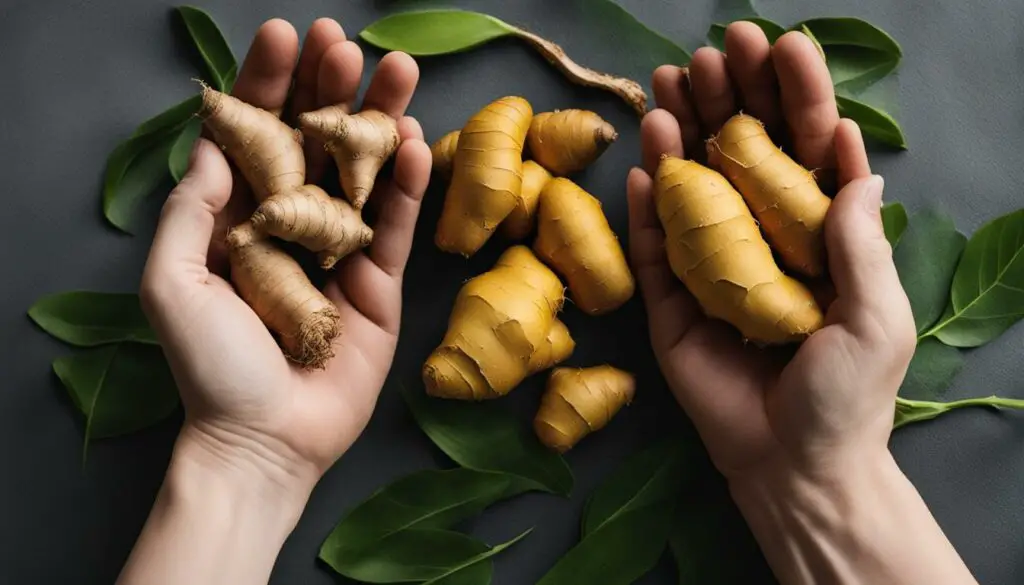
Fresh ginger and ground ginger each have their own unique characteristics and uses in cooking. Understanding the differences between the two can help you determine when to use fresh ginger and when to opt for ground ginger in your recipes.
Fresh ginger, which is the root of the ginger plant, has a strong and vibrant flavor. Its taste is peppery, zesty, and slightly sweet. Fresh ginger is commonly used in savory dishes such as stir-fries, curries, and marinades. Its freshness adds a burst of flavor and aroma to the dish.
Ground ginger, on the other hand, is made from dried and powdered ginger root. It has a more concentrated flavor compared to fresh ginger. Ground ginger is commonly used in baking and spice blends, adding warmth and depth to recipes. It is great for enhancing the flavors of cookies, cakes, and other desserts.
To summarize the differences:
| Fresh Ginger | Ground Ginger |
|---|---|
| Strong and vibrant flavor | Concentrated flavor |
| Used in savory dishes: stir-fries, curries, marinades | Used in baking and spice blends |
Using fresh ginger in recipes: Fresh ginger adds a bold and fresh flavor to your dishes. Its unique taste complements savory recipes, giving them a lively and aromatic twist. Try using fresh ginger in stir-fries, soups, sauces, and marinades to add depth and complexity to your meals.
Using ground ginger in recipes: Ground ginger is excellent for adding warmth and spice to both sweet and savory recipes. It is a staple in baking and can be used in gingerbread, cookies, cakes, and even beverages like ginger tea. Ground ginger is also great for creating spice blends for rubs and marinades.
Remember, fresh ginger and ground ginger can be substituted for each other in recipes, but keep in mind that the flavor intensity may vary. Use approximately 1 tablespoon of fresh ginger for every 1/4 teaspoon of ground ginger, or 1/4 teaspoon of ground ginger for every tablespoon of fresh ginger.
Substitute for Fresh Ginger
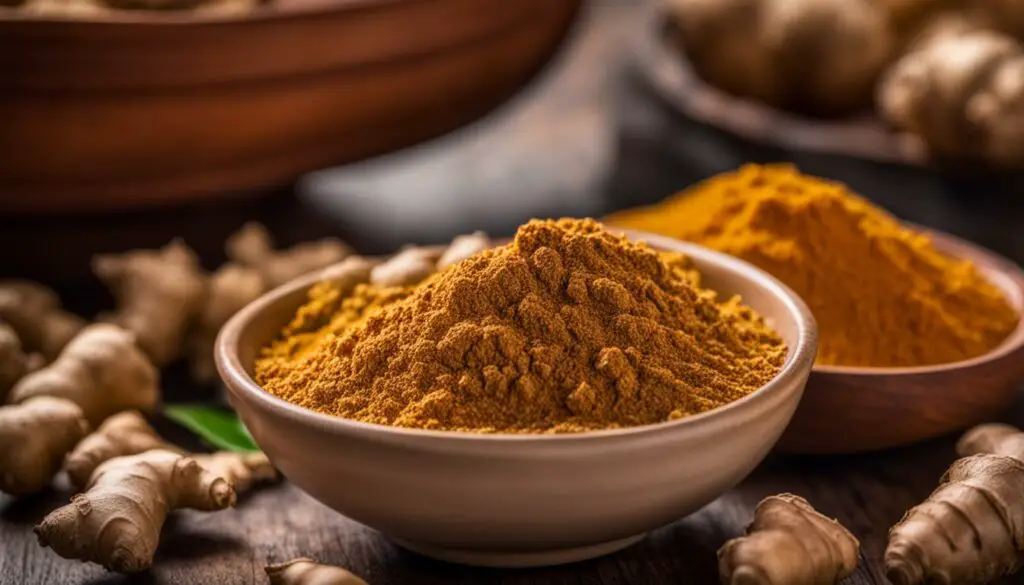
If you don’t have fresh ginger on hand, there are several alternatives you can use. One option is to substitute ground ginger for fresh ginger. Use 1/4 teaspoon of ground ginger for every tablespoon of fresh ginger called for in the recipe. Other substitutes for fresh ginger include ginger paste, minced ginger, or even frozen ginger. Each substitute will provide a slightly different flavor profile, so choose the substitute that best fits your taste preferences and the dish you are making.
“Fresh ginger is not always readily available, but there are plenty of options to replace it in your recipes.”
If you find yourself without fresh ginger while preparing a dish, there’s no need to worry. By using suitable substitutes, you can still achieve the desired flavor and aroma. Ground ginger is a convenient alternative that can be easily found in most spice racks. When substituting ground ginger for fresh ginger, remember that the flavor may be slightly different, but it will still add a delightful zing to your dish.
Here’s a quick guide on how to substitute ground ginger for fresh ginger:
| Amount of Fresh Ginger | Amount of Ground Ginger |
|---|---|
| 1 tablespoon | 1/4 teaspoon |
Another substitute for fresh ginger is ginger paste. Similar to ground ginger, ginger paste offers a concentrated flavor that can effectively replace fresh ginger in your recipes. It is usually sold in tubes and can be found in the refrigerated section of grocery stores.
If you have fresh ginger but need an alternative form for convenience or to extend its shelf life, consider mincing or grating the ginger. This will give you small, fine pieces that can be easily incorporated into your dishes. You can also freeze fresh ginger to preserve it for future use. Just peel the ginger, grate it, and store it in an airtight container in the freezer. Frozen ginger works well in recipes that require cooking or blending.
When choosing a substitute for fresh ginger, consider the overall flavor profile of your dish. Ginger paste, minced ginger, or frozen ginger may not offer the exact same taste as fresh ginger, but they can still infuse your recipes with a delightful hint of ginger.
Substitute for Ground Ginger
If you find yourself without ground ginger in your pantry, don’t worry! There are several substitutes you can try to achieve a similar flavor profile. While fresh ginger is the most common substitute for ground ginger, other spices can also be used as alternatives. Consider the flavor of your dish and choose the substitute that best complements the other ingredients.
Fresh Ginger: When substituting fresh ginger for ground ginger, use approximately 1 tablespoon of grated or minced fresh ginger for every 1/4 teaspoon of ground ginger required in your recipe. Fresh ginger has a vibrant and zingy taste, which adds a robust flavor to your dishes. The fresh ginger will provide a more intense ginger flavor compared to ground ginger.
Spices: If you don’t have fresh ginger on hand, you can turn to other spices to replace ground ginger in your recipe. Here are a few options:
- Allspice: Commonly used in baking, allspice has warm and aromatic notes with hints of cloves, cinnamon, and nutmeg. Use approximately 1/4 teaspoon of allspice as a substitute for 1 teaspoon of ground ginger.
- Cinnamon: Known for its sweet and slightly spicy flavor, cinnamon can add warmth and depth to your recipe. You can substitute 1 teaspoon of ground ginger with 1/2 to 3/4 teaspoon of cinnamon, depending on your taste preferences.
- Nutmeg: With its earthy and nutty flavor, nutmeg can provide a similar taste profile to ginger. Substitute 1 teaspoon of ground ginger with 1/2 teaspoon of nutmeg for a warm and aromatic substitute.
- Turmeric: While turmeric doesn’t have the exact same flavor as ginger, it can provide a similar vibrant and slightly bitter taste. Use 1 teaspoon of ground turmeric in place of 1 teaspoon of ground ginger for a colorful and flavorful substitute.
Remember, each substitute will have its own unique flavor, so it’s essential to consider the overall taste of your dish when choosing a replacement for ground ginger. Experiment with different spices to find the perfect substitute that suits your culinary preferences. Happy cooking!
Using Crystallized Ginger in Recipes

If you’re looking to add a sweet and spicy twist to your recipes, consider using crystallized ginger, also known as candied ginger. Made by cooking fresh ginger in a sugar syrup and then drying it, crystallized ginger brings a unique flavor to both sweet and savory dishes. Its versatile nature allows you to explore various culinary possibilities.
Crystallized ginger is a popular addition to baked goods, such as cookies, cakes, and muffins, where its sweet and spicy flavor can enhance the overall taste. You can also incorporate it into trail mixes for an extra burst of flavor and texture. Additionally, crystallized ginger makes an excellent garnish for cocktails, adding a touch of sophistication and complexity to your drink.
When using crystallized ginger as a substitute for fresh or ground ginger, keep in mind that it is sweeter and less spicy. Adjust the amount according to your taste preferences and the desired level of ginger flavor in your dish. Below is a table summarizing the key differences between crystallized ginger, fresh ginger, and ground ginger:
| Ginger Type | Flavor | Uses |
|---|---|---|
| Crystallized Ginger | Sweet and spicy | Baked goods, trail mixes, cocktails |
| Fresh Ginger | Strong and vibrant | Stir-fries, curries, marinades |
| Ground Ginger | Concentrated flavor | Baking, spice blends |
By understanding the unique characteristics of each ginger type, you can experiment with different recipes and combinations to create delightful culinary creations. So, why not give crystallized ginger a try and elevate your dishes with its distinctive flavor?
Other Substitutes for Ginger
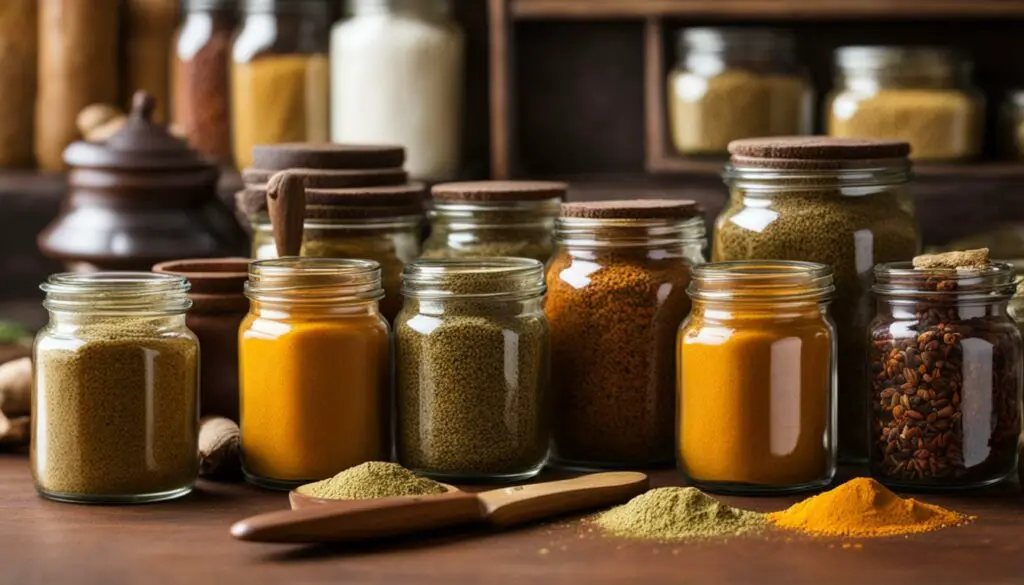
If you don’t have ginger or any of its substitutes on hand, there are other spices and ingredients you can use to replicate the flavor of ginger. Allspice, cinnamon, nutmeg, turmeric, and cardamom are some spices that can provide a similar warmth and spiciness to dishes. Each spice has its own unique flavor profile, so choose the substitute that complements your recipe the best.
For a quick reference, here is a table summarizing the common ginger substitutes and their flavor profiles:
| Substitute | Flavor Profile |
|---|---|
| Allspice | Warm, sweet, and slightly peppery |
| Cinnamon | Sweet, woody, and slightly spicy |
| Nutmeg | Rich, nutty, and subtly sweet |
| Turmeric | Earty, aromatic, and slightly bitter |
| Cardamom | Warm, citrusy, and slightly floral |
Experiment with these spices to find the perfect ginger flavor substitute for your cooking needs. Remember to adjust the quantities based on your preference and the intensity of the substitute. Now let’s explore some delicious recipes that showcase the versatility of ginger substitutes!
Health Benefits of Ginger
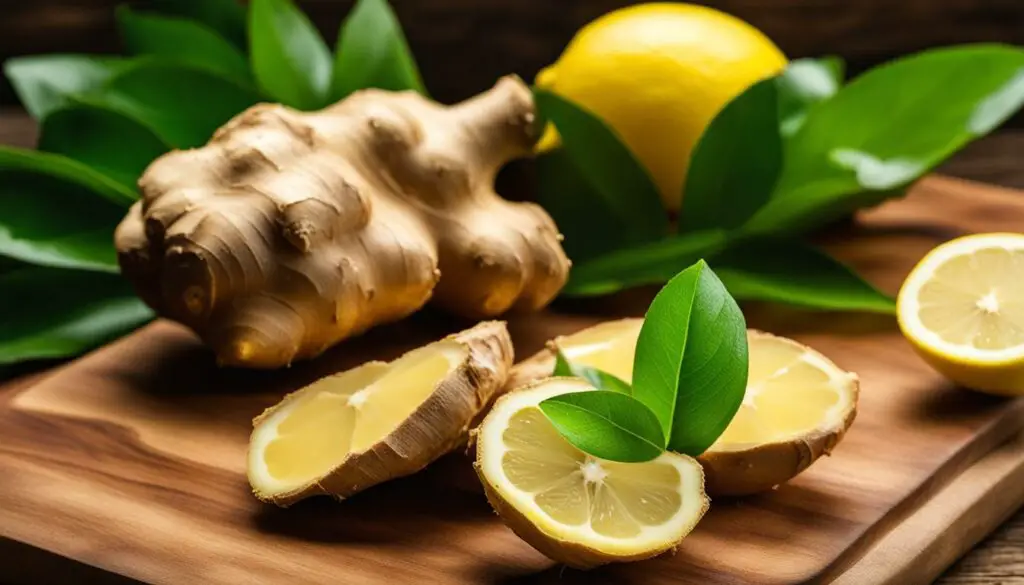
In addition to its culinary uses, ginger offers a wide range of health benefits. Known for its anti-inflammatory properties, ginger can help alleviate various health issues and promote overall well-being. Here are some of the key health benefits of ginger:
- Inflammation: Ginger has been shown to have powerful anti-inflammatory effects, making it beneficial for conditions like arthritis and joint pain.
- Digestion: Ginger aids in digestion by reducing bloating, improving gut health, and relieving gastrointestinal discomfort.
- Nausea: Ginger has long been used as a natural remedy for nausea, including morning sickness, motion sickness, and chemotherapy-related nausea.
- Joint Pain: The anti-inflammatory properties of ginger can help alleviate joint pain caused by conditions like osteoarthritis.
- Menstrual Pain: For women experiencing menstrual cramps, ginger can provide relief by reducing pain and inflammation.
- Brain Function: Studies have shown that ginger may improve brain function and cognitive abilities, potentially reducing the risk of age-related cognitive decline.
- Cholesterol: Ginger has been found to have cholesterol-lowering properties, which can contribute to a healthier heart and reduced risk of heart disease.
To enjoy these health benefits, incorporate ginger into your diet by adding it to dishes, teas, smoothies, or taking ginger supplements. Consulting with a healthcare professional is recommended, especially if you have any underlying health conditions or are taking medication.
Ginger is a versatile spice that not only enhances the flavor of your dishes but also promotes your well-being. Allow ginger to spice up your meals and bring numerous health advantages to your life!
Where to Buy Ginger

Fresh ginger, ground ginger, and crystallized ginger can be found in most grocery stores and online. When buying fresh ginger, look for thick pieces with smooth skin and a strong fragrance. Ground ginger is readily available in the spice aisle, and crystallized ginger can be found in the baking section or bulk supply with nuts and seeds. Consider buying ginger from a trusted source to ensure freshness and quality.
Where to Buy Fresh Ginger
Fresh ginger is widely available in grocery stores, farmers’ markets, and specialty food stores. Look for it in the produce section, usually near other root vegetables. When selecting fresh ginger, choose pieces that are firm, smooth, and plump. Avoid any ginger that looks wrinkled, soft, or moldy. The aroma should be strong and fragrant.
Where to Buy Ground Ginger
Ground ginger is a common spice found in most grocery stores. You can find it in the spice aisle alongside other dried herbs and spices. Look for reputable spice brands and check the expiration date to ensure freshness. Consider buying smaller containers of ground ginger to maintain its flavor and potency.
Where to Buy Crystallized Ginger
Crystallized ginger, also known as candied ginger, can be found in the baking section of grocery stores or in specialty stores that sell bulk dried fruits and nuts. Look for it in packages or in the bins where you can scoop out the desired amount. Crystallized ginger adds a sweet and spicy kick to both sweet and savory dishes, making it a versatile ingredient to have in your pantry.
Recipes with Ginger
Ginger is a versatile ingredient that adds a unique and zesty flavor to both sweet and savory dishes. Whether you’re a fan of fresh ginger, ground ginger, or ginger spice blends, there are countless recipes that showcase the deliciousness and versatility of this spice.
For those looking to experiment with ginger in their cooking, here are some delightful recipes to try:
Ginger Spice Cookies
If you have a sweet tooth, you’ll love these ginger spice cookies. Made with a combination of ground ginger, cinnamon, and nutmeg, these cookies are soft and chewy with a hint of warmth and spice. They make a perfect treat for any occasion.
Ginger-Glazed Salmon
For a savory dish with a touch of sweetness, try ginger-glazed salmon. The fresh ginger adds a zesty flavor to the salmon, while the glaze made of soy sauce, honey, and ginger creates a delectable sticky coating. Serve it with steamed rice and your favorite vegetables for a complete meal.
Carrot and Ginger Soup
Warm up your taste buds with a comforting and flavorful carrot and ginger soup. This creamy soup is packed with the natural sweetness of carrots and the zing of ginger. It’s the perfect dish for a cozy night in.
Stir-Fried Ginger Beef
Tender strips of beef tossed with fresh ginger, garlic, soy sauce, and vegetables make for a delicious and quick stir-fry. The ginger adds a vibrant kick to the dish, complementing the savory flavors of the beef and vegetables.
Spiced Gingerbread Pancakes
Start your day with a stack of spiced gingerbread pancakes. Made with a blend of ginger, cinnamon, nutmeg, and molasses, these pancakes are a delightful twist on a classic breakfast favorite. Top them with maple syrup and whipped cream for an extra treat.
Ginger Spice Latte
Indulge in a warm and comforting ginger spice latte. Made with a blend of ginger, cinnamon, cloves, and black tea, this cozy drink is perfect for a chilly day. Garnish it with a sprinkle of ground cinnamon for an added touch of warmth.
These are just a few examples of the many delicious recipes that incorporate ginger. Whether you’re a fan of ginger-flavored desserts or savory dishes with a kick, there’s a ginger-inspired recipe out there waiting for you to try.
Conclusion
Fresh ginger and ground ginger are versatile ingredients that can be easily substituted for each other in recipes. Understanding the flavor profiles and characteristics of these two forms of ginger allows you to make informed decisions when it comes to swapping them. Whether you’re in need of a fresh ginger substitute or a ground ginger alternative, there are several options available that will ensure your dishes still have that signature ginger flavor.
Experimenting with different substitutes and recipes is the key to finding your favorite ginger flavor combinations. If you don’t have fresh ginger on hand, ground ginger can be a convenient and equally flavorful replacement. Conversely, if ground ginger is not available, fresh ginger can be used in smaller quantities to achieve a similar taste.
So, whether you’re whipping up a stir-fry, baking a batch of cookies, or preparing a marinade, don’t let the absence of fresh ginger or ground ginger hold you back. With the knowledge of their interchangeability and the availability of suitable substitutes, you can confidently embark on your culinary adventures. Discover new ginger-infused recipes, embrace the unique flavors, and enjoy the delightful taste of ginger in all its forms. Happy cooking!
FAQ
What are some tips for substituting fresh ginger with ground ginger and vice versa?
To substitute fresh ginger with ground ginger, use 1/4 teaspoon of ground ginger for every tablespoon of fresh ginger called for in the recipe. When substituting ground ginger with fresh ginger, use 1 tablespoon of fresh ginger for every 1/4 teaspoon of ground ginger.
What does ginger taste like?
Ginger has a peppery, sweet, and pungent taste. It is known for its zingy and earthy flavor.
What is the difference between fresh ginger and ground ginger?
Fresh ginger is the root of the ginger plant and has a strong and vibrant flavor. It is commonly used in stir-fries, curries, and marinades. Ground ginger is made from dried and powdered ginger and has a more concentrated flavor. It is often used in baking and spice blends.
What can I use as a substitute for fresh ginger?
Alternatives to fresh ginger include ground ginger, ginger paste, minced ginger, and frozen ginger. Each substitute will provide a slightly different flavor profile, so choose the one that best fits your taste preferences and the dish you are making.
What can I use as a substitute for ground ginger?
Fresh ginger is the most common substitute for ground ginger. Use 1 tablespoon of fresh ginger for every 1/4 teaspoon of ground ginger. Other options include using spices like allspice, cinnamon, nutmeg, or turmeric. Choose a substitute that complements the flavor profile of your dish.
How can I use crystallized ginger in recipes?
Crystallized ginger, also known as candied ginger, can be used in both sweet and savory dishes. It adds a unique flavor and is often used in baked goods, trail mixes, and as a garnish for cocktails. Keep in mind that crystallized ginger is sweeter and less spicy than fresh or ground ginger, so adjust the amount accordingly.
What are some other substitutes for ginger in cooking?
If you don’t have ginger or any of its substitutes on hand, you can use spices like allspice, cinnamon, nutmeg, turmeric, or cardamom to replicate the flavor of ginger. Each spice has its own unique flavor profile, so choose the substitute that best complements your recipe.
What are the health benefits of ginger?
Ginger has several health benefits, including anti-inflammatory properties and aiding digestion, nausea, and joint pain. It has also been shown to reduce menstrual pain, lower cholesterol, and improve brain function.
Where can I buy ginger?
Fresh ginger, ground ginger, and crystallized ginger can be found in most grocery stores and online. Look for fresh ginger with thick pieces, smooth skin, and a strong fragrance. Ground ginger is available in the spice aisle, and crystallized ginger can be found in the baking section or bulk supply with nuts and seeds.
What are some recipes that use ginger?
Ginger can be used in a variety of recipes, both sweet and savory. It pairs well with spices like nutmeg, cinnamon, and allspice in baked goods and desserts. In savory dishes, ginger adds a zesty and pungent flavor to stir-fries, curries, and marinades. Explore different recipes that incorporate ginger to discover new flavor combinations and culinary delights.
Can fresh ginger and ground ginger be substituted for each other?
Yes, fresh ginger and ground ginger can be substituted for each other in recipes. By understanding their flavor profiles and characteristics, you can make informed decisions about which one to use and how to swap them.
Source Links
- https://bakeitwithlove.com/ginger-substitute/
- https://www.savoryspiceshop.com/blogs/news/behind-the-seasoning-ginger
- https://insanelygoodrecipes.com/substitutes-for-ginger/
See also:
Leave a Reply